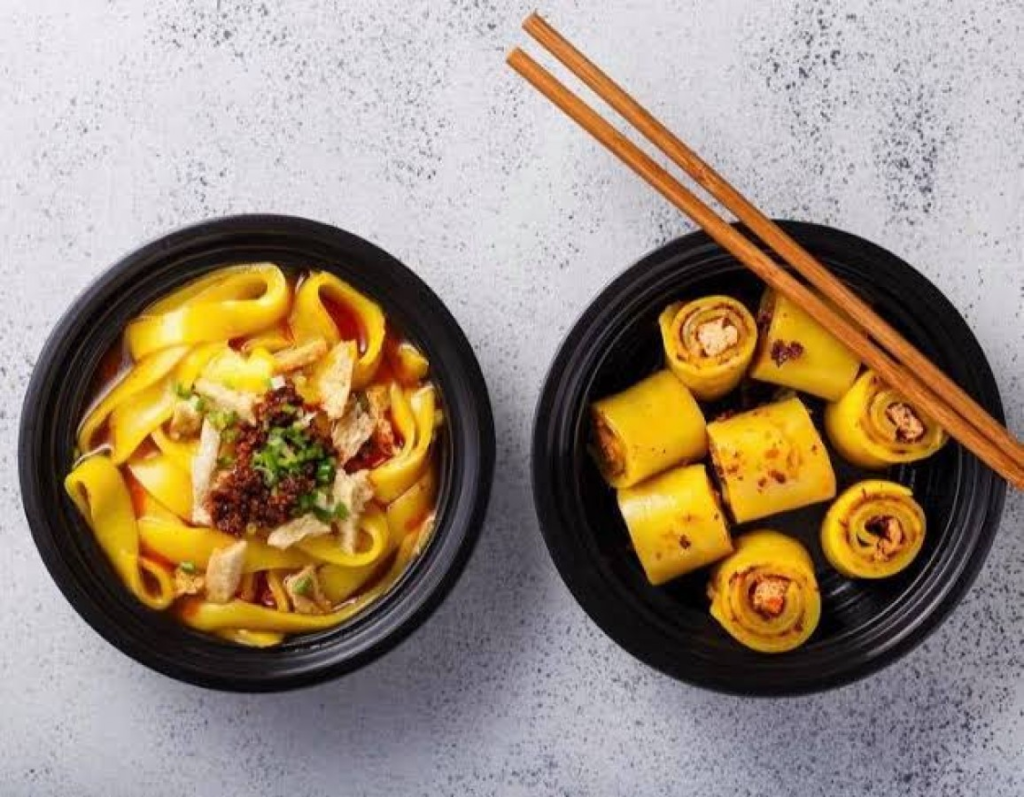You are a foodie who loves discovering exciting new dishes from around the world. But have you heard of Laphing, Tibet’s delicious signature noodle dish? With its mix of rice noodles, chillies, soy sauce and crunchy veggies, Laphing is a flavour explosion that will have your taste buds doing a happy dance. The locals in Tibet cannot get enough of this moreish meal. And once you try it, you will be hooked too. Laphing is the new love language for globetrotting foodies. So join the club and let your Laphing love affair begin! This hearty and wholesome noodle bowl packs a tasty punch that will transport your taste buds to the Himalayas with every mouthwatering bite.
What Is Laphing? An Introduction to Tibet’s Comforting Noodle Dish
Laphing noodles
Laphing is Tibet’s signature noodle dish made of hand-pulled noodles in a hearty bone broth. The noodles are similar to Chinese la mian, made from wheat flour dough that is repeatedly stretched and folded. The result is a bowl of long, slurpy noodles in a flavorful broth.
Hearty bone broth
The broth is made by simmering beef or mutton bones for hours until the liquid becomes a rich, savoury broth. It is often seasoned with soy sauce, sesame oil, chilli oil, and fresh herbs like cilantro. The broth is deeply nourishing, with collagen and minerals from the bones. For many Tibetans, Laphing is comfort food that conjures up feelings of home.
Customise it
Laphing is highly customizable. You can add tender meat such as beef brisket, mutton, or yak. Mushrooms, bamboo shoots, corn, peas, and green onions are also common additions. Chilli oil, fresh chillies, garlic, and ginger add spice and flavour to suit your tastes. Laphing brings people together over a hot, steaming bowl of noodles and broth. Whether enjoying it at a street food stall, food cart or at home, Laphing is meant for sharing with others.
Where to find it
Laphing can be found throughout Tibet and neighbouring regions of China. Look for Laphing at Tibetan restaurants, street food stalls, and food carts. Some places offer beef, mutton or vegetarian versions. If you get a chance to try Laphing, slurp up those noodles and savour the flavours of Tibet. This comforting dish is not to be missed!

How to Make Authentic Yummy Laphing at Home
To make Laphing at home, you will need a few essential ingredients.
Ingredients
- Rice noodles: Laphing noodles are made from rice flour and water. Look for dried rice vermicelli noodles.
- Bean sprouts: Fresh mung bean sprouts provide crunch.
- Green onions: Chopped green onions or scallions add flavour, colour and texture.
- Lime: Fresh lime juice brings a bright, tangy kick.
- Soy sauce: Light soy sauce is used for seasoning and as a condiment.
- Chilli oil (optional): Chilli oil provides heat and spice. Add to taste.
- Peanuts (optional): Crushed peanuts add protein, fat and extra crunch.
Instructions
Bring a pot of water to a boil. Add the rice noodles and cook until al dente, about 3 to 5 minutes. Drain and rinse with cold water.
Add the bean sprouts, green onions, lime juice, soy sauce, chilli oil (if using), and peanuts (if using) to the noodles. Toss to combine.
You can also add shredded or sliced cooked chicken, pork, beef or tofu for a heartier dish. Serve the Laphing at room temperature or chilled.
Laphing is meant to be interactive – add your favourite toppings like fresh herbs, shredded cabbage or carrots. Mix and match for a burst of flavours and textures in every bite. Your homemade Laphing will be even tastier than the restaurant version! Enjoy your yummy Laphing – the flavours of Tibet are now in your kitchen.

Why Laphing Is a Tibetan Must-Have for Foodies
Laphing is a dish that epitomises Tibetan cuisine and culture. As a noodle soup, it is comforting yet vibrant, symbolic of the resilience and warmth of the Tibetan people. Foodies looking to discover exciting new flavours should make Laphing a must-try.
A Mix of Textures and Flavours
The hallmark of any memorable dish is contrasting textures and complex flavours. Laphing delivers on both fronts. Slippery mung bean noodles nestle in a broth infused with chilli oil and Sichuan pepper. Crispy fried shallots provide crunch, while tender strips of beef, pork or mushrooms add substance. A sprinkle of fresh herbs adds brightness. With each bite, you experience a burst of flavours – spicy, savoury, earthy and herbaceous.
A Window into Tibetan Culture
Beyond the bowl, Laphing offers insight into Tibetan culture. The dish originated in Amdo, in eastern Tibet, and spread throughout the region. Noodles symbolise long life, while the vibrant red broth is thought to ward off evil spirits. Laphing is usually eaten in the community, with diners crowding around and eagerly slurping from their bowls. Trying Laphing offers a glimpse into this communal eating tradition and the cultural symbolism behind the dish.
For foodies seeking adventure, Laphing should be top of the list. More than just a meal, it is an opportunity to discover a vibrant new cuisine and gain insight into Tibetan culture, all in a single, delicious bowl. Slurping encouraged! Laphing is a must-have experience for any curious foodie.
Conclusion
So there you have it – everything you need to know about Laphing, Tibet’s soul-warming noodle soup. From its origins to key ingredients, cooking tips and where to find the best bowls, this comforting carb-fest has got your name written all over it. The next time you are craving comfort food with a twist, look no further than this hug in a bowl. Just do not forget to slurp loudly – it is the Laphing way! With a newfound love for this huggable dish, your tastebuds will be endlessly thankful. So get cooking and get ready to fall head over heels for Laphing.






